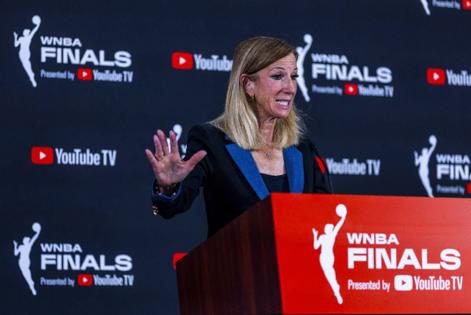WNBA Finals overshadowed by labor dispute as lockout looms
Published in Basketball
The Las Vegas Aces’ win in Game 1 of the WNBA finals on Friday brought them a step closer to winning a championship. Yet for many players, teams and fans, eyes are already on the offseason.
As the Aces and the Phoenix Mercury battle, the Women’s National Basketball Players Association and league leadership are locked in their own standoff. The entities have yet to agree on terms for a collective bargaining agreement, and with an Oct. 31 deadline looming, the reality that a lockout could occur — potentially delaying or canceling the 2026 season — is beginning to sink in.
“We’re working really hard,” WNBA commissioner Cathy Engelbert said at a press conference before Game 1, adding that there’ll be meetings in the coming week. She acknowledged that a stoppage could hurt the momentum that the league has built and indicated there could be a need for an extension. “While I hope we make the Oct. 31 deadline — and that is a real deadline from that perspective — we have extended deadlines in the past.”
The tension was heightened this week when Minnesota Lynx star Napheesa Collier criticized Engelbert, saying the league has the “worst management in the world,” and assailed its officiating as well. Players, coaches and fans have decried the league’s referees for allowing more aggressive styles of play. Several stars suffered season-ending injuries this year, including Collier and star Indiana Fever guard Caitlin Clark.
Engelbert told reporters that she and the league would “do better” to make sure players feel appreciated and valued, and said she’s never been a “quitter” when asked if she’s the right person to lead the league.
The stakes are high. WNBA ratings have surged the last few seasons, boosting revenue. The league has also signed new media deals, including one announced this week with USA Network.
Given the increase in revenue and viewership, players have advocated for higher salaries and improved retirement benefits. During the league’s All-Star Weekend, they donned black T-shirts with “pay us what you owe us” printed on them.
The union opted out early from its CBA last October, Bloomberg first reported, with the goal of securing a new contract. But little progress has been made, and a potential stoppage in play could threaten the league’s momentum.
McKaylee Croll, a Vegas fan who traveled from Oklahoma, and who used to play basketball herself, said the impact could be drastic.
“I don’t like watching the NBA as much as I do the WNBA, so a lot of women wouldn’t be able to watch the WNBA if these women are going to go on strike,” she said, adding that the players are “not getting paid what they should be getting paid.”
Players’ union demands
The current CBA, signed in 2020, increased players’ maximum salary to about $250,000 this season and made gains pertaining to female wellness, including paid maternity leave. But the salary gap compared to the NBA remains vast. WNBA and NBA 2025 first-overall draft picks Paige Bueckers and Cooper Flagg earned first-year salaries of $78,000 and $13.8 million, respectively.
The terms of the current deal also mandate that the league increase its revenue by more than 20% a year for two consecutive years in order for players to earn a share. Bloomberg previously reported that the WNBA generated $144 million in league revenue in 2024, a 177% increase since 2019. It was the first year that league revenue swelled enough to hit its annual 20% target and compensate for prior years of mixed targets.
The players want a different system, and their demands recently earned the attention of lawmakers in Congress. In September, 85 members of the Democratic Women’s Caucus and House Democratic Caucus wrote to the WNBA, urging the league to bargain “in good faith” with the union and reach a CBA before the deadline.
“We’re in the biggest moment in WNBA history,” Clark said this week after her team finished the season just short of the Finals. “Everybody that’s in a place of power has a true responsibility, even myself. We have a responsibility to make sure this game is in a great place going forward with the CBA.”
Other U.S. pro sports leagues, including the NFL, MLB and NBA, have undergone stoppages before while they negotiated on terms. But the timing of WNBA’s labor unrest has frustrated some, who argue it’s overshadowed the playoffs.
“It’s really the finals. It’s really locking in on getting the job done. We’ve got four to get and then we can go full throttle,” Phoenix Mercury All-Star guard Kahleah Copper told reporters on Thursday about the negotiations.
As uncertainty surrounds near year, the offseason three-on-three league of Collier and three-time WNBA champion Breanna Stewart, called Unrivaled, has expanded its roster.
The league reached a $340 million valuation, and has doubled revenue projections and increased salaries. Pay for the initial season was already more than double the minimum base salary in the WNBA, offering players the opportunity to remain in the U.S. as opposed to playing abroad in the offseason.
“I think honestly, at this point, the fans will still stay and support, even if there isn’t a league next year, because of Unrivaled and things like that,” said DeMario Hudson, whose first WNBA game as a spectator was the Vegas-Mercury matchup, for which he traveled from Kenosha, Wis.
One thing is clear. Even as the league’s best teams battle for a championship, few things are guaranteed when it comes to preserving their rosters for next year.
“You want to retain as much talent as you can, you want to keep a championship-contending core intact,” Nikki Fargas, president of the Las Vegas Aces, said in an interview. “With us not knowing because we have to get through the agreement, you hope that how you play, how you conduct yourself, the relationship that you’ve built over the years, that when that time comes and you’re able to get in front of a free agent, that your goals and their goals mirror each other.”
©2025 Bloomberg L.P. Visit bloomberg.com. Distributed by Tribune Content Agency, LLC.







Comments